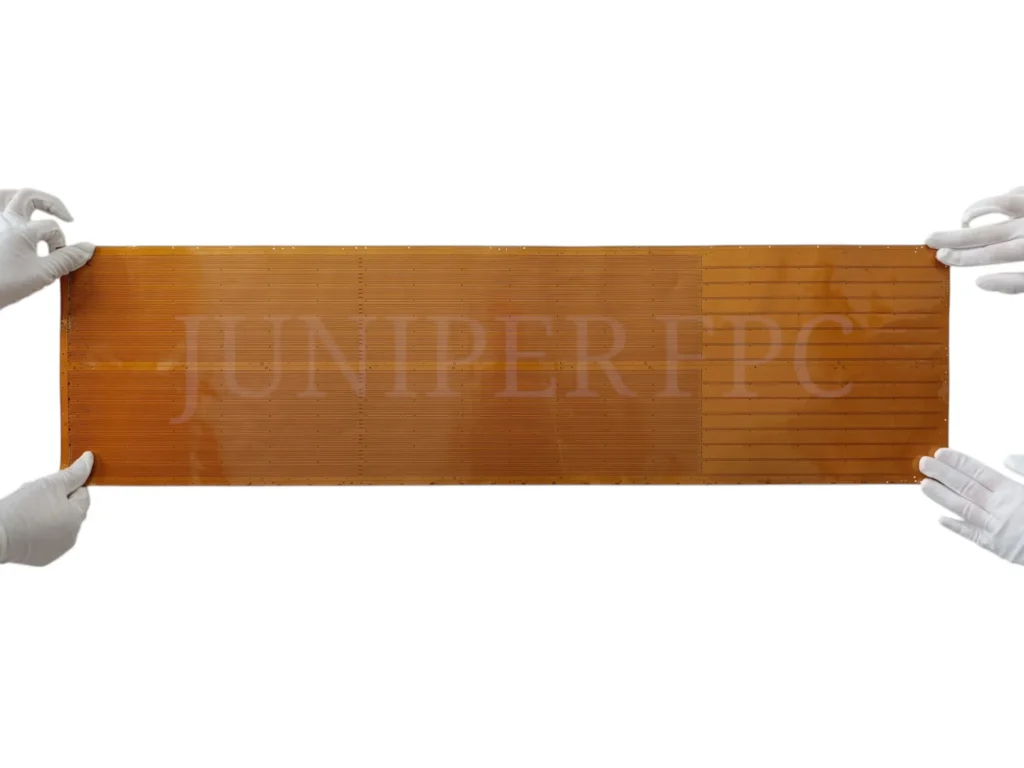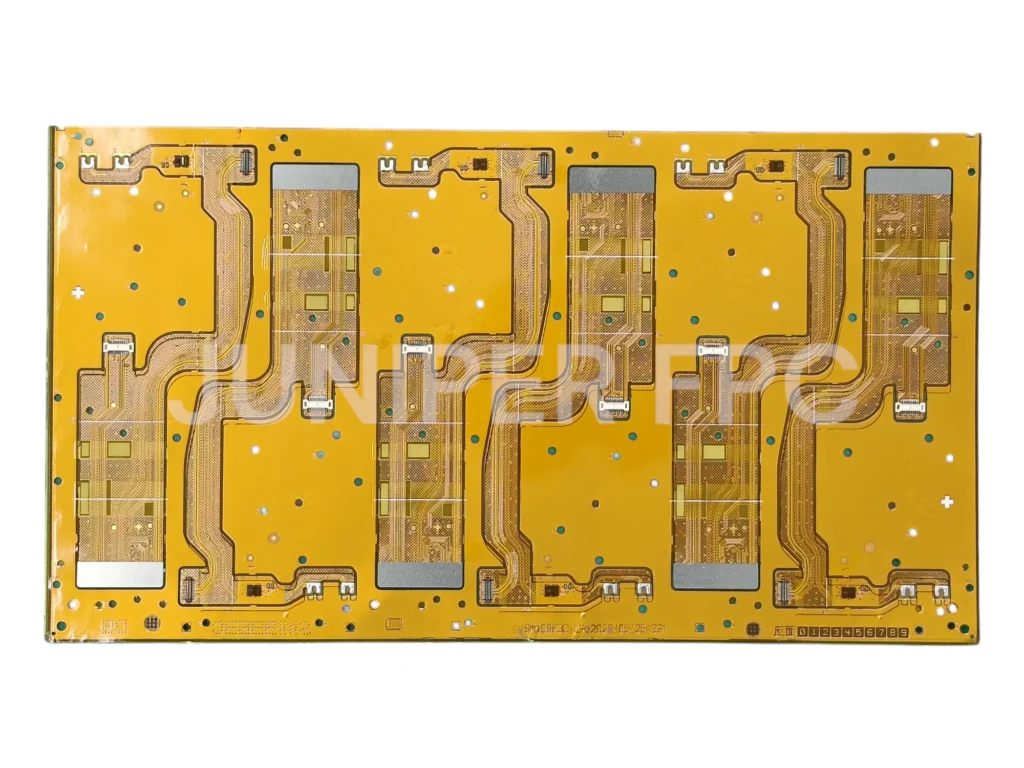Are you struggling with space limitations in your electronic design? Flex PCBs (Flexible Printed Circuit Boards) offer a game-changing solution. These innovative circuits provide exceptional flexibility and durability, enabling designs that can bend, twist, and conform to complex shapes. But to leverage their full potential, it’s essential to understand how Flex PCBs work and their unique advantages.
A flexible PCB (Flex PCB), also known as a flex circuit, is a type of printed circuit board (PCB) that is designed to be flexible and capable of bending, twisting, or folding. Unlike traditional rigid PCBs, which are typically made from materials such as polyimide, polyester, or PEN (Polyethylene Naphthalate). These materials are chosen for their excellent mechanical flexibility, electrical performance, and thermal stability, which allow the PCB to bend, fold, and conform to different shapes without compromising its functionality. Unlike rigid PCBs that rely on hard substrates.
This flexibility allows for integration into space-constrained, dynamic environments like wearable devices, medical equipment, and aerospace applications, where traditional rigid PCBs fall short. Understanding the structure and benefits of Flex PCBs is key to optimizing your design and performance.
Now that we’ve defined what Flex PCBs are, let’s explore their advantages, applications, and why they’re a go-to solution in various industries.

What is a Flex Board?
A flex board is a type of printed circuit board made from flexible materials, allowing it to bend or fold while maintaining electrical functionality. This type of PCB is used in applications that require compact, flexible, and durable circuits.
Flex boards are typically used in applications such as wearables, smartphones, and medical devices. These designs are tailored to fit specific spaces where traditional rigid PCBs would not be feasible. The ability to bend and conform to different shapes allows for more creative, efficient, and versatile electronic designs.
What is a Flex Cut PCB?
A Flex Cut PCB is a specific type of Flex PCB that is cut or separated into distinct sections, often used for applications where the circuit needs to be routed in tight spaces or around obstacles. This cutting process is done precisely to maintain the integrity of the PCB while allowing it to fit in various designs.
Flex cut PCBs can offer enhanced flexibility and customization, enabling engineers to design compact, lightweight, and high-performance devices. These boards are commonly used in industries like automotive, consumer electronics, and medical technology, where space and adaptability are crucial.
What is the Difference Between Flex and Non-Flex PCB?
The primary difference between Flex and Non-Flex PCBs (rigid PCBs) lies in their structure. While Flex PCBs are made from flexible substrates, allowing them to bend and fold, rigid PCBs are made from hard, inflexible materials like fiberglass.
Flex PCBs offer significant advantages when it comes to space-saving and adaptability, especially in compact designs or products that require flexibility, such as wearables and medical devices. Rigid PCBs, on the other hand, are ideal for applications requiring high stability and are typically used in traditional electronics, such as desktop computers and televisions.

What are the Disadvantages of Flexible PCBs?
Despite their many advantages, flexible PCBs come with some challenges. One of the major disadvantages is their higher cost compared to rigid PCBs due to the use of specialized materials and more complex manufacturing processes.
Additionally, the flexibility of these PCBs makes them more vulnerable to physical damage during handling and assembly. They may also face limitations in the number of layers and the types of components that can be integrated, making them less suitable for certain applications.
What is the Difference Between Rigid PCB and Flex PCB?
The key difference between rigid PCBs and Flex PCBs is the material used. Rigid PCBs are made from solid, inflexible substrates like fiberglass, while Flex PCBs are built using flexible materials such as polyimide or polyester. This allows Flex PCBs to bend, twist, and fold without losing their functionality.
Rigid PCBs are typically used in applications where space constraints and flexibility are not a concern, while Flex PCBs are chosen for designs that require high adaptability, compactness, and the ability to conform to unique shapes. Rigid-flex PCBs combine the best of both worlds, offering both rigid and flexible properties in one board for complex designs that need both flexibility and stability.

How Thick is a Flex PCB?
The thickness of a Flex PCB can vary depending on the design and material requirements. Typically, the thickness of a Flex PCB ranges from 0.1mm to 0.5mm, though it can be customized to meet specific needs. Thinner PCBs are used in applications that require ultra-compact designs, while thicker boards provide increased durability and stability.
The thickness of a Flex PCB is also influenced by the number of layers, with multi-layer designs generally being thicker than single-layer PCBs. The choice of thickness impacts both the electrical performance and mechanical properties of the PCB.
What are the Materials Used in Flex PCB?
Flex PCBs are made from flexible materials that allow them to bend and conform to complex shapes. The primary materials used include polyimide, polyester, and polyethylene naphthalate (PEN). Polyimide is the most commonly used material due to its excellent thermal stability, high dielectric strength, and resistance to wear and tear.
In addition to the flexible substrate, Flex PCBs use copper traces and conductive materials to create the circuit paths. The choice of materials depends on the specific requirements of the application, including factors like temperature resistance, electrical conductivity, and mechanical strength.

Flex PCB Applications
Flex PCBs are used in a variety of industries where traditional rigid PCBs cannot meet the design requirements. Their ability to bend, fold, and conform to different shapes makes them ideal for products that require space efficiency, flexibility, and durability. Common applications of Flex PCBs include:
- Wearable Devices: Flex PCBs enable the design of slim, flexible, and lightweight wearables such as smartwatches, fitness trackers, and health-monitoring devices.
- Medical Equipment: Flex PCBs are often used in medical devices like diagnostic equipment, sensors, and implantable devices where space is at a premium.
- Consumer Electronics: Flex PCBs are also used in smartphones, tablets, and other compact consumer electronics that require compact designs without sacrificing performance.
- Aerospace: In aerospace, Flex PCBs help reduce the overall weight of systems while providing reliable performance in harsh conditions.
The versatility and durability of Flex PCBs make them an ideal solution for electronics that need to function in dynamic and space-constrained environments.

How to Choose the Right Flex PCB Manufacture
Choosing the right Flex PCB manufacturer is critical for ensuring high-quality products and meeting delivery timelines. Here are a few key factors to consider:
- Manufacturing Capabilities: Ensure the manufacturer has experience in producing custom Flex PCB designs and can meet the specific requirements of your project.
- Material Selection: The Flex PCB material used can greatly impact the performance and durability of the board. Work with a manufacturer who can provide a variety of material options based on your needs.
- Quality Control: The manufacturer should have strict quality control measures to ensure the final product meets your specifications, including electrical performance, flexibility, and reliability.
Top-tier manufacturers will also offer the flexibility to customize Flex PCBs thickness and integrate various technologies to meet your design requirements. Companies like JLCPCB are well-known for providing high-quality, cost-effective PCB production.

Summary
Flex PCBs offer exceptional flexibility and design freedom, making them an essential component in modern electronics. From medical devices to wearables, their ability to bend and adapt to different shapes offers solutions that rigid PCBs simply can’t. Understanding their material properties, design options, and applications will help you choose the right solution for your next project.
